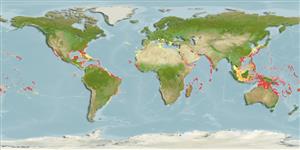Pycnogonida |
Pantopoda |
Ammotheidae
Environment: milieu / climate zone / depth range / distribution range
Ecology
Benthic; depth range 0 - 65 m (Ref. 2115). Tropical
Indo-Pacific, Eastern Central Atlantic and the Mediterranean: Melanesia, Polynesia.
Length at first maturity / Size / Weight / Age
Maturity: Lm ? range ? - ? cm
Body ovoid in dorsal view; lateral processes separated by less than their diameters. Palps 9 segmented; terminal 5 segments short, setose. Chelifore scapes 2-segmented, moderately long but shorter than bulbous proboscis, with vestigial chelae lacking fingers. Ovigers 10 segmented, with 1 or 2 denticulate spines on terminal 4 segments. Abdomen and legs with several long, tubular dorsal spines and regular pointed spines. Dorsodistal femoral cement gland tube long, robust. Propodus with 4 large heel spines; claw and auxiliaries long (Ref. 2115, p. 12).
Coastal to shelf (Ref. 19). Epibiotic (Ref. 116112). Known from Carrie Bow Cay in sand trough behind outer reef ridge, in coral, sand, and rubble (Ref. 2086). Part of a fouling community (Ref. 126174).
Life cycle and mating behavior
Maturity | Reproduction | Spawning | Eggs | Fecundity | Larvae
Members of the class Pycnogonida are gonochoric and sexually dimorphic. During copulation, male usually suspends itself beneath the female. Fertilization occurs as the eggs leave the female's ovigers. Males brood the egg masses until they hatch. Life cycle: Eggs hatch into protonymphon larva then to adults.
Bamber, R.N. 2004 Pycnogonids (Arthropoda: Pycnogonida) from French Cruises to Melanesia. Zootaxa 551:1-27. (Ref. 1852)
IUCN Red List Status
(Ref. 130435: Version 2025-1)
CITES status (Ref. 108899)
Not Evaluated
Not Evaluated
Threat to humans
Human uses
| FishSource |
Tools
More information
Trophic EcologyFood items (preys)
Diet composition
Food consumption
Predators
Population dynamicsGrowth
Max. ages / sizes
Length-weight rel.
Length-length rel.
Length-frequencies
Mass conversion
Abundance
Life cycleReproductionMaturityFecunditySpawningEggsEgg developmentLarvae PhysiologyOxygen consumption
Human RelatedStamps, coins, misc.
Internet sources
Estimates based on models
Preferred temperature
(Ref.
115969): 22.9 - 28.4, mean 26.7 (based on 860 cells).
Price category
Unknown.
